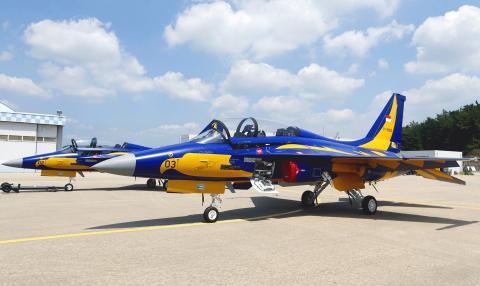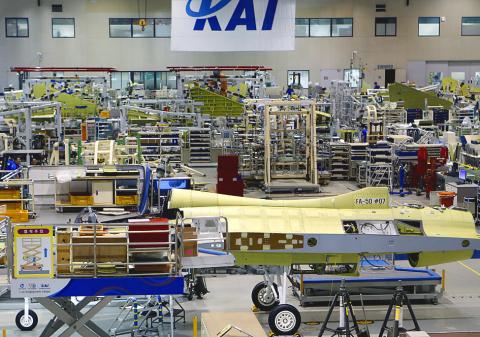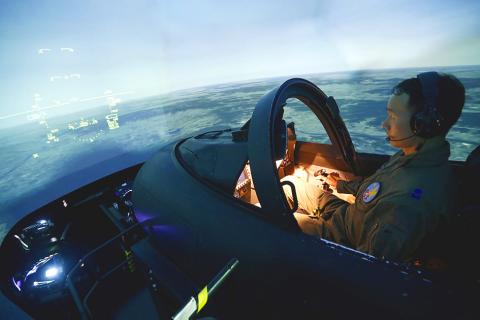South Korea, renowned for making high-tech consumer devices, cars and ships, now has its sights on exporting fighter jets amid a projected sharp increase in demand for military weapons in Asia over the next decade.
Korea Aerospace Industries Ltd (KAI) on Tuesday rolled out the nation’s first home-built light fighter — the FA-50 — from its assembly plant in the southern city of Sacheon.
KAI officials say that they aim to sell about 1,000 FA-50s and T-50s overseas over the next three decades, and are eyeing markets in Southeast Asia, Eastern Europe and the Americas.

Photo: Reuters
“Countries in Southeast Asia and South America are finding FA-50s enormously attractive,” Park Jeong-soo, a senior official from KAI’s external affairs department, told reporters.
Global defense budgets are forecast to increase by 9.3 percent to US$1.65 trillion by 2021, according to analysts IHS Janes.
Defense budgets in the Asia-Pacific region are forecast to outstrip that in North America by 2021, up 35 percent from this year’s levels to US$501 billion, it added in its Balance of Trade report in June.

Photo: Reuters
That will pit South Korea’s fighters against US, European, Chinese and Russian companies in an increasingly crowded — yet still lucrative — market.
BUDGET CONSTRAINTS
South Korea is also planning to develop a much larger KF-X fighter with the help of US defense contractors, although that has been delayed by budgetary constraints.

Photo: Reuters
The first FA-50 is part of an order for 20 fighters by South Korea’s air force, which will use them to replace its aging Northrop F-5 fighters.
Negotiations are ongoing with the Philippines, with a local online news outlet reporting that a US$460 million deal with Manila for 12 FA-50s could be completed this month.
Officials at the Sacheon headquarters of KAI declined to comment due to the sensitivity of the matter.
KAI chief executive officer Ha Sung-yong said that while South Korea’s conventional export markets such as cars and shipbuilding faced tough competition, its aerospace industry should grow strongly.
“Now that KAI has established the groundwork with its own technology, it is necessary to grow the industry ... by contributing to the national military’s force integration and creating jobs and exports,” Ha said.
LOCKHEED
The FA-50 is based on the T-50 advanced jet trainer, which is already in service in South Korea and was developed together with US defense contractor Lockheed Martin.
The T-50 can also be fitted with weapons under its wings and used as a light attack aircraft. Indonesia was the first export customer with a 2011 order for 16 T-50s, and Iraq is in negotiations to buy 24.
KAI and Lockheed are gearing up for a lucrative US Air Force competition for at least 300 aircraft and maybe hundreds more worth several billion dollars, a deal that one South Korean officer called the “jackpot.”

Shares in Taiwan closed at a new high yesterday, the first trading day of the new year, as contract chipmaker Taiwan Semiconductor Manufacturing Co (TSMC, 台積電) continued to break records amid an artificial intelligence (AI) boom, dealers said. The TAIEX closed up 386.21 points, or 1.33 percent, at 29,349.81, with turnover totaling NT$648.844 billion (US$20.65 billion). “Judging from a stronger Taiwan dollar against the US dollar, I think foreign institutional investors returned from the holidays and brought funds into the local market,” Concord Securities Co (康和證券) analyst Kerry Huang (黃志祺) said. “Foreign investors just rebuilt their positions with TSMC as their top target,

REVENUE PERFORMANCE: Cloud and network products, and electronic components saw strong increases, while smart consumer electronics and computing products fell Hon Hai Precision Industry Co (鴻海精密) yesterday posted 26.51 percent quarterly growth in revenue for last quarter to NT$2.6 trillion (US$82.44 billion), the strongest on record for the period and above expectations, but the company forecast a slight revenue dip this quarter due to seasonal factors. On an annual basis, revenue last quarter grew 22.07 percent, the company said. Analysts on average estimated about NT$2.4 trillion increase. Hon Hai, which assembles servers for Nvidia Corp and iPhones for Apple Inc, is expanding its capacity in the US, adding artificial intelligence (AI) server production in Wisconsin and Texas, where it operates established campuses. This

Nvidia Corp chief executive officer Jensen Huang (黃仁勳) on Monday introduced the company’s latest supercomputer platform, featuring six new chips made by Taiwan Semiconductor Manufacturing Co (TSMC, 台積電), saying that it is now “in full production.” “If Vera Rubin is going to be in time for this year, it must be in production by now, and so, today I can tell you that Vera Rubin is in full production,” Huang said during his keynote speech at CES in Las Vegas. The rollout of six concurrent chips for Vera Rubin — the company’s next-generation artificial intelligence (AI) computing platform — marks a strategic

US President Donald Trump on Friday blocked US photonics firm HieFo Corp’s US$3 million acquisition of assets in New Jersey-based aerospace and defense specialist Emcore Corp, citing national security and China-related concerns. In an order released by the White House, Trump said HieFo was “controlled by a citizen of the People’s Republic of China” and that its 2024 acquisition of Emcore’s businesses led the US president to believe that it might “take action that threatens to impair the national security of the United States.” The order did not name the person or detail Trump’s concerns. “The Transaction is hereby prohibited,”